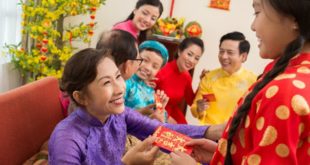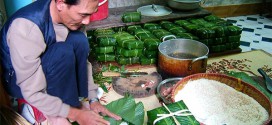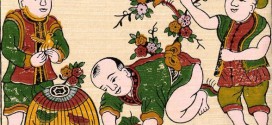Clean and Decorate the Home
Before New Year’s Eve, it is customary in Vietnam to thoroughly clean and decorate the home. Here are some key practices:
- Sweeping and Scrubbing: Children take charge of sweeping and scrubbing the floors, symbolizing the removal of bad fortunes from the old year.
- Kitchen Cleaning: The kitchen is cleaned before the 23rd night of the last month. It is believed that this action ensures a fresh start for the new year.
- Ancestral Altars: The head of the household cleans the dust and ashes from incense on the ancestral altars, paying respect to the ancestors and seeking their blessings for the coming year.
- House Painting and Decoration: Many people choose to paint their houses and adorn them with festive items to create a vibrant and joyful atmosphere.
Literally Means “Getting New Clothes”
One of the most exciting traditions for children during the Vietnamese New Year is receiving new clothes. Here are some important aspects:
- Preparation: Parents purchase new clothes and shoes for their children about a month before the New Year.
- Wearing Restrictions: Children must wait until the first day of the New Year to wear their new outfits. The best attire is typically reserved for this auspicious day.
Farewell Ceremony for the Kitchen Gods (Ong Tao)
Seven days before Tet, Vietnamese families perform a farewell ceremony for the Kitchen Gods, Ong Tao. This ceremony involves offering prayers and incense to send Ong Tao back to Heaven Palace. His role is to report the family’s affairs to the Jade Emperor, the supreme deity, for the past year.
New Year’s Eve: Passage from the Old to the New Year
Giao Thua, or New Year’s Eve, holds significant meaning in Vietnamese culture. It symbolizes the transition from the old year to the new year and involves the following beliefs:
- Zodiac Animals: Vietnamese believe that 12 sacred animals from the Zodiac take turns overseeing the affairs of the Earth. Giao Thua marks the moment when the old chief (representing the previous year’s animal) passes his power to the new chief (representing the upcoming year’s animal).
- Return of Ong Tao: Giao Thua also marks the return of Ong Tao, the Kitchen God, to Earth after completing his annual report to the Jade Emperor. Families perform open-air ceremonies to welcome him back into their kitchens.
The Aura of the Earth
During Giao Thua, the first guest to visit and offer greetings is considered significant. If this guest possesses a good aura, such as being respected, educated, successful, or famous, it is believed that the family will receive luck and good fortune throughout the year. This belief, known as “xong dat,” remains prevalent, particularly among families involved in business.
Apricot Flowers and Peach Flowers
Flowers play a symbolic role during Tet. Two prominent flowers associated with the holiday are:
- Hoa Mai: Yellow apricot flowers commonly seen in Southern Vietnam. They thrive in the region’s hot weather and symbolize new beginnings.
- Hoa Dao: Warm pink peach blossoms that complement the dry, cold weather of Northern Vietnam. These flowers represent the arrival of spring.
Giving Away Red Envelopes (Lucky Money)
The tradition of giving red envelopes filled with lucky money has been passed down through generations. Here are some key aspects:
- Symbolism: Red envelopes symbolize luck and wealth, and they are commonly given by older generations to younger ones.
- Greeting Ritual: Before receiving the red envelopes, the younger individuals must perform a respectful greeting to the elders, wishing them well for the
 Vietnamese Culture and Tradition
Vietnamese Culture and Tradition 


